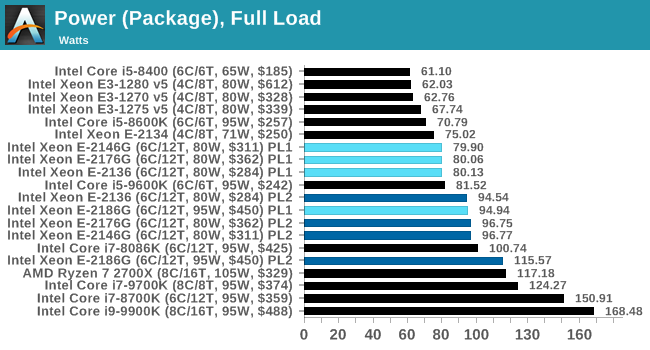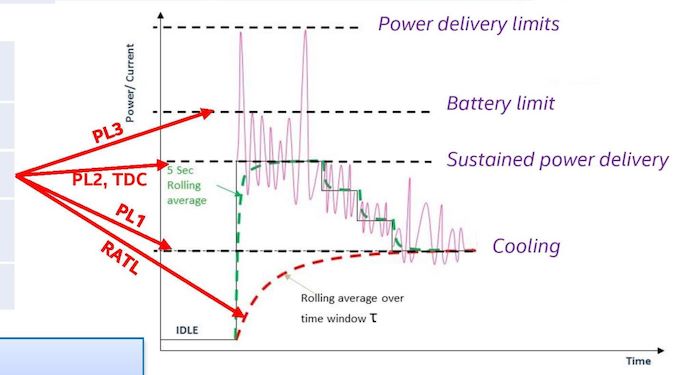Intel Xeon E Six-Core Review: E-2186G, E-2176G, E-2146G, and E-2136 Tested
by Ian Cutress on November 5, 2018 12:00 PM EST- Posted in
- CPUs
- Intel
- Xeon
- Enterprise CPUs
- Xeon E
Power Consumption
How TDP Works
Over the last decade, while the use of the term TDP (thermal design power) has not changed much, the way that processors use a power budget has. Inside each processor, Intel defines several power levels based on the capabilities and expected operating environments. This sounds all well and good, however these power levels and capabilities can be adjusted at the firmware level, allowing OEMs to decide how they want the processors to perform in their systems. Ultimately it gives a really fuzzy reading at exactly what the power consumption of a processor will be when it is in a system.
To simplify, there are three numbers to be aware of. Intel calls these numbers PL1 (power level 1), PL2 (power level 2), and T (or tau).
- PL1 is the effective long-term expected steady state power consumption of a processor. For all intents and purposes, the PL1 is usually defined as the TDP of a processor. So if the TDP is 80W, then PL1 is 80W.
- PL2 is the short-term maximum power draw for a processor. This number is higher than PL1, and the processor goes into this state when a workload is applied, allowing the processor to use its turbo modes up to the maximum PL2 value. This means that if Intel has defined a processor with a series of turbo modes, they will only work when PL2 is the driving variable for maximum power consumption. Turbo does not work in PL1 mode.
- Tau is a timing variable. It dictates how long a processor should stay in PL2 mode before hitting a PL1 mode. Note that Tau is not dependent on power consumption, nor is it dependent on the temperature of the processor (it is expected that if the processor hits a thermal limit, then a different set of super low voltage/frequency values are used and PL1/PL2 is discarded).
So let us go on a journey where a large workload is applied to a processor.
Firstly, it starts in PL2 mode. If a single-threaded workload is used, then we should hit the top turbo value as listed in the spec sheet. Normally a single thread will consume nowhere near the PL2 power limit. As we load up the cores, the processor reacts by reducing the turbo frequency in line with the per-core turbo values dictated by Intel. If the power consumption of the chip hits the PL2 value, then the frequency is adjusted so PL2 is never exceeded.
When the system has a substantial workload applied for a fixed time, in this case ‘tau’ seconds, the firmware should immediately invoke PL1 as the new power limit. The turbo tables no longer apply.
If the workload applied produces a power consumption above PL1, then the frequency and voltages are adjusted such that the overall power consumption of the chip is within the PL1 value. This usually means that the whole processor reduces in frequency, often to the base frequency, for the duration of the workload. This means that temperatures on the processor should decrease, increasing the longevity of the processor.
PL1 stays in place until the workload is removed and a CPU core hits an idle state for a fixed amount of time (usually sub 5-seconds). After this, the system can re-enable PL2 again if another workload is applied.
So some examples of numbers here – Intel lists several in its specification sheets for the different processors. In this case, I will take a consumer grade Core i7-8700K. For this processor, we have the following:
- PL1 = TDP = 95 W
- PL2 = TDP * 1.25 = 118.75 W
- Tau = 8 seconds
In this case, the system should be able to boost up to ~119W for eight seconds, before being pulled back down to 95W. This has actually been in place for a number of generations of processors, and most of the time it didn’t actually matter, as the power draw for the full chip was often well below the PL1 value even at full load.
However, this is where it gets really stupid: the motherboard vendors got involved, because PL1, PL2 and Tau are configurable in firmware. Motherboard manufacturers can do what they like, and that gets frustrating
With a commercial product like Xeon E, we would expect a motherboard to adhere to Intel’s standards moreso than a high-end consumer motherboard, right? Well we do.

The high-end Xeon E-2186G has a TDP of 95W, and a PL2 of 119W, and if we record the load power after a few seconds, it hits 116W. The long term power, measured about 20 seconds into the load, is 95W. For the other chips, they all have a TDP of 80W, and a PL2 of 100W, and we record the short load power at 95-97W, and the long load power at 80W. These numbers stayed true even when we run a workload for a considerable time – so while PL2 and Tau are both set to Intel recommended values. No other desktop processor we've tested has ever done this, unless it was bundled in an SFF system.











48 Comments
View All Comments
Jorgp2 - Monday, November 5, 2018 - link
Why don't you guys test iGPU encoding performance?speculatrix - Tuesday, November 6, 2018 - link
I agree, it would be useful to see video transcode performance, there's a few times when you want a media server with fast video transcode performance (i.e. real time 1080p60).Samus - Tuesday, November 6, 2018 - link
I'd also like to know where Quicksync performance lies on the new Xeons...mooninite - Wednesday, November 7, 2018 - link
Yes! I'd love to see iGPU encoding numbers, too. I would be buying one of these Xeons to get the encoding offloading you couldn't get with a Threadripper or EPYC.kuttan - Sunday, November 11, 2018 - link
For iGPU encoding you don't need a Xeon. For that any IGP based consumer desktop CPUs like Core i3/i5 or AMD Ryzen 2400G APU will do at a much cheaper price.mooninite - Tuesday, November 13, 2018 - link
@kuttan, you don't understand. I need a *server* system that has IPMI. i3/i5 or Ryzen systems don't provide IPMI. I also need a Micro ATX formfactor with 10GBASE-T NICs. Not going to happen on a i3/i5 or Ryzen system. Thanks though.Vidmo - Wednesday, November 7, 2018 - link
Agreed!shiznit - Wednesday, November 21, 2018 - link
no kidding... top 5 use case for these Xeons.just4U - Monday, November 5, 2018 - link
Thru-out the article I kept thinking.. Oh look a 6core product when 8core processors are becoming the norm at reasonable prices in desktop computers. In server settings I wonder why that would even be something to write home about.Ratman6161 - Monday, November 5, 2018 - link
Well, you really have to want/need that ECC RAM to make this worthwhile. Otherwise there is no point to going with an "E" over the equivalent desktop part.